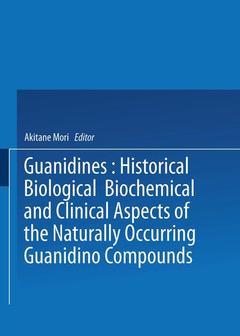Guanidines, Softcover reprint of the original 1st ed. 1985 Historical, Biological, Biochemical, and Clinical Aspects of the Naturally Occurring Guanidino Compounds
Langue : Anglais
Coordonnateur : Mori Akitane

In 1978, we had the first research meeting of guanidine compound analysis in Okayama, Japan. The purpose of the meeting was to standardize the methods of analyzing guanidino compounds, because the analytic methods, even, for example, that of normal plasma, were quite different from laboratory to laboratory at that time. More than ten laboratories joined in this research project. Thereafter, the purpose of the annual meetings was extended to cover general biochemistry of guanidino compounds, and every meeting has served to promote our mutual growth and progress. The last meeting of the Japan Guanidino Compounds Research Association in 1982 brought together more than 80 members, and about 30 papers were presented there. This, the 6th annual meeting, brings the International Symposium on Guani dino Compounds here to Tokyo. Recently, many scientists are engaged in the research of guanidine compounds, especially in the field of clinical bio chemistry. I am sure that the observation of guanidinosuccinic acid in the urine of uremic patients by Dr. Cohen's research group in 1963 ignited the recent exploration of the role of guanidino compounds in renal diseases. The study of guanidino compounds does, however, have a long history. The first knowledge of guanidine was obtained by Strecker in 1861 (Annalen der Chemie und Pharmacie, 118, 151- 177, 1981).
I. Analytical Method for Guanidino Compounds.- New high-speed fully automated guanidino compound analyzer.- Automatic guanidine analyzer using benzoin as a fluorogenic reagent.- Simple methods for the determination of methylguanidine and guanidinosuccinic acid in biological fluids.- Enzymic determination of methylguanidine in urine.- II. Metabolism of Guanidino Compound in Normal and Abnormal Organs, and in Metabolic Diseases.- Developmental changes in guanidino compounds levels in mouse organs.- Developmental changes of guanidino compounds in chick embryo.- Metabolism of L-(amidino-15N)-arginine to guanidine compounds.- Biosynthesis of guanidinoacetic acid in isolated rat hepatocytes.- Biosynthesis of guanidinosuccinic acid in isolated rat hepatocytes: evaluation of guanidine cycle and acidosis.- The role of the liver as a significant modulator of the serum guanidinoacetic acid level in man.- Conversion of urea nitrogen into protein nitrogen by a freshwater fish, sarotherodon mossambicus.- Topographical distribution of sheep brain arginase: its response to some guanidino compounds.- The effects of sodium valproate on blood ammonia levels and the concentrations of guanidino compounds in mouse tissue.- The guanidine cycle.- Arginine utilization in muscle and kidney of frog during ammonotoxemia.- Arginine metabolism in citrullinemic patients.- Studies on the occurrence of guanidino compounds in serum and urine of patients with epilepsy, neuronal ceroid-lipofuscinosis and uremic patients.- Determination of guanidino compounds in plasma and urine of patients with argininemia before and during therapy.- Hyperargininemia: treatment with sodium benzonate and phenylacetic acid.- III. Physiological, Pharmacological and Toxicological Aspects of Guanidino Compound.- Effect of methylguanidine on muscle protein synthesis.- Effect of methylguanidine on erythrocyte membranes.- Taurine and the actions of guanidinoethane sulfonate.- Effects of guanidinoethane sulfonate and taurine on electroshock seizures in mice.- Effect of taurine, taurocyamine and anticonvulsants on dibenzoylguanidine-induced convulsions and their relation to brain monoamine levels in ddY and El mice.- Effect of chronic alcohol administration on the concentrations of guanidino compounds in rat organs.- IV. Involvement of Guanidino Compound in Acute and Chronic Renal Faiure.- Guanidino compounds: Implications in uremia.- A study of creatine metabolism in chronic renal failure rats.- Guanidino compounds in patients with acute renal failure.- Possibility of a common metabolic pathway for the production of methylguanidine and dimethylamine in chronic renal failure.- Guanidinoacetic acid (GAA) in patients with chronic renal failure (CRF) and diabetes mellitus (DM).- Metabolic changes of guanidino compounds in acute renal failure complicated with hepatic disease.- Urinary guanidinoacetic acid excretion in gentamicin nephrotoxicity.- The importance of energy intake for preventing accumulation of guanidino compounds in patients with chronic renal failure.- The effect of lactulose on the metabolism of guanidino compounds in chronic renal failure.- Evaluation of the efficacy of anti-rejection therapy using the quantitative analysis of guanidinoacetic acid (GAA) urinary excretion as a guide.- Metabolic profiles of guanidino compounds in various tissues of uremic rats.- Guanidinoacetic acid (GAA) deficiency and supplementation in rats with chronic renal failure (CRF).- V. Natural Guanidino Compounds: A Review.- Natural guanidino compounds.- Participants.- Index: Guanidines in Organs.
Date de parution : 03-2013
Ouvrage de 479 p.
17x24.4 cm
Disponible chez l'éditeur (délai d'approvisionnement : 15 jours).
Prix indicatif 105,49 €
Ajouter au panierThèmes de Guanidines :
Mots-clés :
Plasma; alcohol; biochemistry; chemistry; growth; kidney; metabolism; paper; pharmacology; protein; protein synthesis; quantitative analysis; synthesis
© 2024 LAVOISIER S.A.S.



